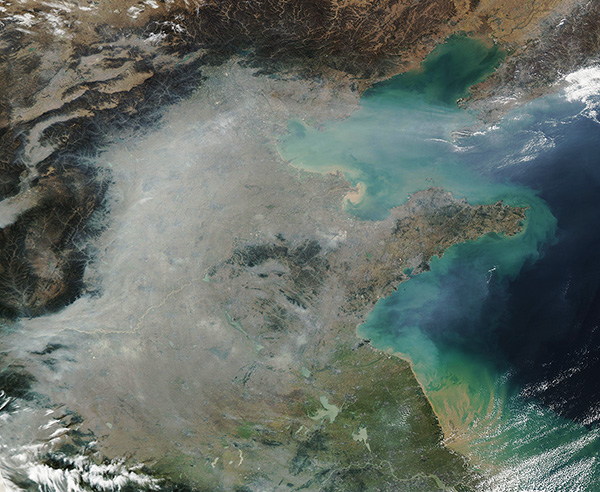Images
October 27, 2024 - Aerosols over China
Tweet
A thick gray haze hung over eastern China intermittently throughout late September and October 2024. The Moderate Resolution Imaging Spectroradiometer (MODIS) on NASA’s Aqua satellite acquired this true-color image of the scene on October 24. At that time, the cloud of aerosols was so thick that it completely obscured the ground from view. The haze also extended over the Bohai Sea, which was filled with bright-colored sediment. In the Yellow Sea, sediment fringed the coastline as the haze thinned.
Aerosols are tiny specks of solid particles and liquid droplets that are suspended in air. They range in size in size from a few nanometers—less than the width of the smallest viruses—to several tens of micrometers—about the diameter of human hair. Meteorologists and regulatory agencies typically call aerosols “particulate matter”, reflecting that they are particles suspended in air. They also define them by size, with PM2.5 or PM10 most often reported. Both of these can have profound impact on health, with PM2.5 the most directly damaging because they are the tiniest and can penetrate deep into the lung when breathed in.
Haze frequently develops over Eastern China, especially in cooler weather, when air becomes trapped lower to the ground due to temperature inversions. While aerosols can come from natural sources (dust, volcanic ash, etc.), much of the aerosol pollution in this region originates from man-made sources, such as industry, vehicles, and coal used for warmth.
Image Facts
Satellite:
Aqua
Date Acquired: 10/24/2024
Resolutions:
1km (626.2 KB), 500m (1.8 MB), 250m (4 MB)
Bands Used: 1,4,3
Image Credit:
MODIS Land Rapid Response Team, NASA GSFC
Tweet
A thick gray haze hung over eastern China intermittently throughout late September and October 2024. The Moderate Resolution Imaging Spectroradiometer (MODIS) on NASA’s Aqua satellite acquired this true-color image of the scene on October 24. At that time, the cloud of aerosols was so thick that it completely obscured the ground from view. The haze also extended over the Bohai Sea, which was filled with bright-colored sediment. In the Yellow Sea, sediment fringed the coastline as the haze thinned.
Aerosols are tiny specks of solid particles and liquid droplets that are suspended in air. They range in size in size from a few nanometers—less than the width of the smallest viruses—to several tens of micrometers—about the diameter of human hair. Meteorologists and regulatory agencies typically call aerosols “particulate matter”, reflecting that they are particles suspended in air. They also define them by size, with PM2.5 or PM10 most often reported. Both of these can have profound impact on health, with PM2.5 the most directly damaging because they are the tiniest and can penetrate deep into the lung when breathed in.
Haze frequently develops over Eastern China, especially in cooler weather, when air becomes trapped lower to the ground due to temperature inversions. While aerosols can come from natural sources (dust, volcanic ash, etc.), much of the aerosol pollution in this region originates from man-made sources, such as industry, vehicles, and coal used for warmth.
Image Facts
Satellite:
Aqua
Date Acquired: 10/24/2024
Resolutions:
1km (626.2 KB), 500m (1.8 MB), 250m (4 MB)
Bands Used: 1,4,3
Image Credit:
MODIS Land Rapid Response Team, NASA GSFC




